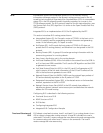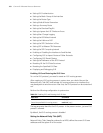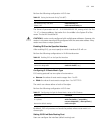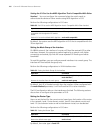
110 CHAPTER 5: IP ROUTING PROTOCOL OPERATION
■ Setting IS-IS Authentication
■ Setting the Mesh Group of the Interface
■ Setting the Router Type
■ Setting Default Route Generation
■ Setting a Summary Route
■ Setting the Overload Flag Bit
■ Setting to Ignore the LSP Checksum Errors
■ Setting Peer Change Logging
■ Setting the LSP Refresh Interval
■ Setting the Lifetime of LSP
■ Setting the SPF Calculation in Slice
■ Setting SPF to Release CPU Resources
■ Setting the SPF Computing Interval
■ Enabling or Disabling the Interface to Send Packets
■ Configuring IS-IS to Import Routes of Other Protocols
■ Configuring IS-IS Route Filtering
■ Setting the Preference of the IS-IS Protocol
■ Resetting All the IS-IS Data Structures
■ Resetting the Specified IS-IS Peer
■ Displaying and Debugging IS-IS
Enabling IS-IS and Entering the IS-IS View
To run the IS-IS protocol, you need to create an IS-IS routing process.
After creating an IS-IS routing process in system view, you should also set the
Network Entity Title (NET) and activate this routing process at an interface that
may be adjacent to another router. After that, the IS-IS protocol can be started and
run.
Perform the following configuration in system view.
The
tag parameter identifies the IS-IS process. In the present version, just one IS-IS
process is allowed.
By default, the IS-IS routing process is disabled.
Setting the Network Entity Title (NET)
Network Entity Titles (hereafter referred to as NETs) define the current IS-IS area
addresses and the system ID of the router.
Table 54 Enabling IS-IS and Entering the IS-IS View
Operation Command
Enable IS-IS and enter the IS-IS view isis [ tag ]
Cancel the specified IS-IS routing process undo isis [ tag ]


















